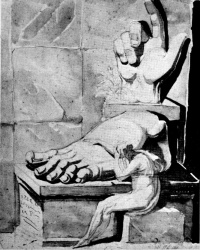Apollo Belvedere
From The Art and Popular Culture Encyclopedia
| Revision as of 13:30, 12 September 2009 Jahsonic (Talk | contribs) (Appolo of Belvedere moved to Apollo of Belvedere) ← Previous diff |
Current revision Jahsonic (Talk | contribs) |
||
| Line 1: | Line 1: | ||
| + | [[Image:The Artist Moved by the Grandeur of Ancient Ruins.jpg|thumb|right|200px| | ||
| + | ''[[The Artist's Despair Before the Grandeur of Ancient Ruins]]'' (1778-80) by Henry Fuseli]] | ||
| + | {| class="toccolours" style="float: left; margin-left: 1em; margin-right: 2em; font-size: 85%; background:#c6dbf7; color:black; width:30em; max-width: 40%;" cellspacing="5" | ||
| + | | style="text-align: left;" | | ||
| + | "... a mouth shaped like that whose touch stirred with delight the loved [[Branchus]]. The soft hair plays about the divine head as if agitated by a gentle breeze, like the slender waving tendrils of the noble vine; it seems to be anointed with the oil of the gods, and tied by Graces with pleasing display on the crown of the head."--''[[History of Ancient Art]]'' (1764) by Winckelmann on the [[Apollo Belvedere]] | ||
| + | |} | ||
| {{Template}} | {{Template}} | ||
| - | [[Appolo of Belvedere]], [[Grottaferrata]]<hr> | + | |
| + | The '''''Apollo Belvedere''''' or '''''Apollo of the Belvedere''''' — also called the '''''Pythian Apollo''''' — is a celebrated [[marble]] [[sculpture]] from [[Classical Antiquity]]. It was rediscovered in the late 15th century, during the [[Renaissance]]. From the mid-18th century, it was considered the greatest ancient sculpture by ardent [[Neoclassicism|neoclassicists]] and for centuries epitomized ideals of [[perfection#Aesthetics|aesthetic perfection]] for Europeans and westernized parts of the world. | ||
| + | ==Works inspired or influenced by the ''Apollo Belvedere''== | ||
| + | *[[Albrecht Dürer|Dürer, Albrecht]], ''[[Adam and Eve]]'' (1504 engraving) | ||
| + | *Copies of the ''Apollo Belvedere'' appear as cultural props in [[Joshua Reynolds]]'s ''Commodore Augustus Keppel'' (1752-3, oil on canvas) and ''Jane Fleming, later Countess of Harrington'' (1778-79, oil on canvas). | ||
| + | *[[Antonio Canova|Canova, Antonio]], ''[[Perseus]]'' (1801, [[Vatican Museums]], 180x, [[Metropolitan Museum of Art]])) | ||
| + | *In ''[[Childe Harold's Pilgrimage]]'' (1812-18), [[Byron]] describes how the statue requites humanity's debt to [[Prometheus]]: "And if it be Prometheus stole from Heaven / The fire which we endure, it was repaid / By him to whom the energy was given / Which this poetic marble hath array'd / With an eternal glory--which, if made / By human hands, is not of human thought; / And Time himself hath hallowed it, nor laid / One ringlet in the dust--nor hath it caught / A tinge of years, but breathes the flame with which 'twas wrought." (IV, CLXIII, 161-163; 1459-67). | ||
| + | *[[Thomas Crawford (sculptor)|Crawford, Thomas]], ''[[Orpheus and Cerberus]]'' (1838-43; [[Boston Athenaeum]], later [[Museum of Fine Arts, Boston]]) | ||
| + | * Apollo tended by the Nymphs of Thetis | ||
| + | * ''Minute Man'' by [[Daniel Chester French]], 1874 at the [[Old North Bridge]] in [[Concord, Massachusetts]] | ||
| + | |||
| {{GFDL}} | {{GFDL}} | ||
Current revision

|
"... a mouth shaped like that whose touch stirred with delight the loved Branchus. The soft hair plays about the divine head as if agitated by a gentle breeze, like the slender waving tendrils of the noble vine; it seems to be anointed with the oil of the gods, and tied by Graces with pleasing display on the crown of the head."--History of Ancient Art (1764) by Winckelmann on the Apollo Belvedere |
|
Related e |
|
Featured: |
The Apollo Belvedere or Apollo of the Belvedere — also called the Pythian Apollo — is a celebrated marble sculpture from Classical Antiquity. It was rediscovered in the late 15th century, during the Renaissance. From the mid-18th century, it was considered the greatest ancient sculpture by ardent neoclassicists and for centuries epitomized ideals of aesthetic perfection for Europeans and westernized parts of the world.
Works inspired or influenced by the Apollo Belvedere
- Dürer, Albrecht, Adam and Eve (1504 engraving)
- Copies of the Apollo Belvedere appear as cultural props in Joshua Reynolds's Commodore Augustus Keppel (1752-3, oil on canvas) and Jane Fleming, later Countess of Harrington (1778-79, oil on canvas).
- Canova, Antonio, Perseus (1801, Vatican Museums, 180x, Metropolitan Museum of Art))
- In Childe Harold's Pilgrimage (1812-18), Byron describes how the statue requites humanity's debt to Prometheus: "And if it be Prometheus stole from Heaven / The fire which we endure, it was repaid / By him to whom the energy was given / Which this poetic marble hath array'd / With an eternal glory--which, if made / By human hands, is not of human thought; / And Time himself hath hallowed it, nor laid / One ringlet in the dust--nor hath it caught / A tinge of years, but breathes the flame with which 'twas wrought." (IV, CLXIII, 161-163; 1459-67).
- Crawford, Thomas, Orpheus and Cerberus (1838-43; Boston Athenaeum, later Museum of Fine Arts, Boston)
- Apollo tended by the Nymphs of Thetis
- Minute Man by Daniel Chester French, 1874 at the Old North Bridge in Concord, Massachusetts

